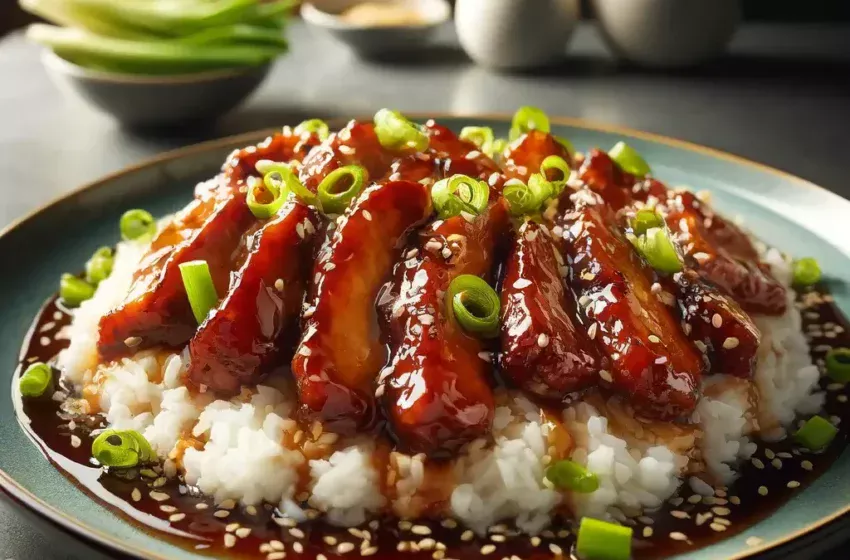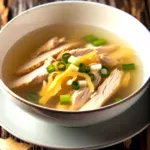Easy Mongolian Pork Recipe: A Flavorful Journey to Savor
As a food reviewer, I’ve had the pleasure of tasting various dishes from around the globe, but the Mongolian Pork recipe stands out for its exceptional blend of flavors, tantalizing the taste buds in a way that few other dishes can. Mongolian Pork, a delightful twist on the more commonly known Mongolian Beef, is a dish that boasts a rich sauce with a perfect balance of sweet and savory, enveloping tender slices of pork in a flavor-packed experience. This recipe not only brings the essence of Mongolian cuisine right into your kitchen but does so in a way that’s both simple and straightforward, making it an ideal choice for a weeknight dinner or a special occasion. Below, I’ll guide you through each step to prepare this mouthwatering dish, share pro tips, and explain why this recipe will become a new favorite.
How To Make Mongolian Pork Recipe
- Preparation Time
15 minutes - Cooking Time
20 minutes - Serves
4 people - Difficulty
Easy
Ingredients
- 500g (1lb) pork tenderloin, thinly sliced
- 2 tablespoons vegetable oil
- 1/4 cup soy sauce
- 1/2 cup water
- 3/4 cup dark brown sugar
- 1 tablespoon fresh ginger, minced
- 2 cloves garlic, minced
- 2 tablespoons cornstarch mixed with 2 tablespoons water
- 3 green onions, chopped
- For serving: Cooked white rice or noodles
Instructions
Step 1: Prepare the Pork
Begin by slicing the pork tenderloin into thin strips. This ensures that the pork will cook quickly and absorb the sauce more effectively.
Step 2: Cook the Pork
Heat the vegetable oil in a large pan over medium-high heat. Add the pork strips and cook until they are browned and cooked through. Remove the pork from the pan and set aside.
Step 3: Make the Sauce
In the same pan, add the soy sauce, water, dark brown sugar, ginger, and garlic. Bring the mixture to a simmer, stirring until the sugar has dissolved.
Step 4: Thicken the Sauce
Mix the cornstarch with water and stir it into the sauce. Keep stirring until the sauce has thickened.
Step 5: Combine Pork with Sauce
Return the pork to the pan and toss to coat all the pieces with the sauce. Cook for an additional 2-3 minutes.
Step 6: Final Touches
Stir in the chopped green onions and remove from heat. Serve your Mongolian Pork over a bed of white rice or noodles for a complete meal.
Pro Tips For Mongolian Pork Recipe
- For extra flavor, marinate the pork slices in a mixture of soy sauce and garlic for 30 minutes before cooking.
- If you prefer a spicier dish, add a teaspoon of red pepper flakes to the sauce.
Why You Will Love Mongolian Pork Recipe
This Mongolian Pork recipe is not just a dish; it’s an experience. It’s easy to make, requiring ingredients you likely already have in your pantry. The dish’s rich flavors and tender pork will make it a hit among both adults and children. It’s versatile, serving well with rice, noodles, or even vegetables, making it perfect for any occasion.
How to Eat Mongolian Pork
Mongolian Pork is best enjoyed hot, served over a generous portion of fluffy white rice or your favorite noodles. The sauce is the hero, so make sure to spoon plenty over the pork and carbs to enjoy its full flavor.
Conclusion
In conclusion, this Mongolian Pork recipe is a testament to the beauty of simple ingredients coming together to create a dish that’s both comforting and exotic. It’s a recipe that invites you to explore the flavors of Mongolia from the comfort of your home. If you’ve enjoyed this culinary journey, be sure to share this recipe with friends and family.
You Can Also Read:- Dairy-Free Crockpot Recipe
FAQs on Mongolian Pork Recipe
1. What is Mongolian Pork?
Mongolian Pork is a savory dish featuring thin slices of pork cooked in a rich, flavorful sauce made from ingredients like soy sauce, brown sugar, ginger, and garlic. It’s inspired by Mongolian Beef, a popular restaurant dish.
2. Can I use pork chops instead of pork tenderloin?
Yes, you can use pork chops; just ensure they’re thinly sliced to absorb the sauce better and cook evenly.
3. What kind of soy sauce should I use?
A low-sodium soy sauce is recommended to control the saltiness of the dish, but you can use regular soy sauce if that’s what you have on hand.
4. Is Mongolian Pork spicy?
The basic recipe is not spicy, but you can add red pepper flakes to introduce some heat according to your preference.
5. Can this recipe be made gluten-free?
Yes, by substituting soy sauce with a gluten-free soy sauce or tamari, you can make this dish gluten-free.
6. What sides pair well with Mongolian Pork?
Steamed rice, noodles, or a side of stir-fried vegetables make great pairings with Mongolian Pork.
7. Can I add vegetables to the dish?
Absolutely! Bell peppers, broccoli, or snow peas can be added to make the dish more colorful and nutritious.
8. How do I slice the pork thinly?
Freezing the pork for about 20-30 minutes before slicing can make it easier to cut thin slices.
9. Can Mongolian Pork be made ahead of time?
Yes, you can cook it ahead of time and reheat it, though the pork is best when freshly made as it’s more tender.
10. How long does Mongolian Pork last in the fridge?
Stored in an airtight container, it can last for 3-4 days in the refrigerator.
11. Can I freeze Mongolian Pork?
Yes, it freezes well for up to 3 months. Thaw in the fridge overnight before reheating.
12. How do I thicken the sauce if it’s too runny?
If the sauce is too runny, you can thicken it by adding a bit more cornstarch mixed with water.
13. What if the sauce is too thick?
If the sauce becomes too thick, simply thin it with a little water or broth until you reach the desired consistency.
14. Is Mongolian Pork considered a healthy dish?
While Mongolian Pork is not the lowest in calories due to the sugar and oil, using lean pork and serving it with vegetables can make it a balanced meal.
15. Can I use another type of meat?
Yes, this recipe is versatile. You can substitute pork with beef, chicken, or even tofu for a vegetarian option.
16. What can I use instead of brown sugar?
Honey or maple syrup can be good substitutes for brown sugar, though they will slightly alter the taste.
17. Can I use fresh ginger instead of ground ginger?
Fresh ginger is actually preferred for its stronger flavor, but ground ginger can be used in a pinch.
18. How can I make the dish less sweet?
Reduce the amount of brown sugar according to your taste to make the dish less sweet.
19. What oil is best for cooking Mongolian Pork?
Vegetable oil or any neutral oil with a high smoke point, such as canola or peanut oil, is best.
20. Can I cook Mongolian Pork in a slow cooker?
While possible, the texture of the pork might be different. It’s best cooked quickly over high heat for the right texture.
21. How do I know when the pork is cooked?
The pork is cooked when it’s no longer pink in the middle. Avoid overcooking to keep it tender.
22. Can I add sesame oil to the recipe?
A small amount of sesame oil can be added at the end for an extra layer of flavor.
23. What’s the best way to reheat leftovers?
Reheat gently in a pan over medium heat or in the microwave, covered, to avoid drying out the pork.
24. Can I use bottled ginger-garlic paste?
Yes, bottled ginger-garlic paste works as a convenient substitute for fresh ginger and garlic.
25. Why is my sauce not caramelizing?
Ensure the heat is high enough, and give the sauce time to reduce and thicken, which will lead to caramelization.
26. Is Mongolian Pork authentic Mongolian cuisine?
This dish is more of an American-Chinese creation inspired by Mongolian flavors rather than traditional Mongolian cuisine.
27. Can I make this dish without cornstarch?
Cornstarch is key for thickening the sauce, but arrowroot powder or tapioca starch can be alternatives.
28. How can I add more umami to the dish?
Adding a bit of oyster sauce or fish sauce can enhance the umami flavor of the dish.
29. Can Mongolian Pork be served cold?
It’s best served hot, but cold leftovers can be used in salads or wraps for a different twist.
30. How do I prevent the pork from being chewy?
Slice the pork thinly against the grain, and avoid overcooking it to keep it tender.












